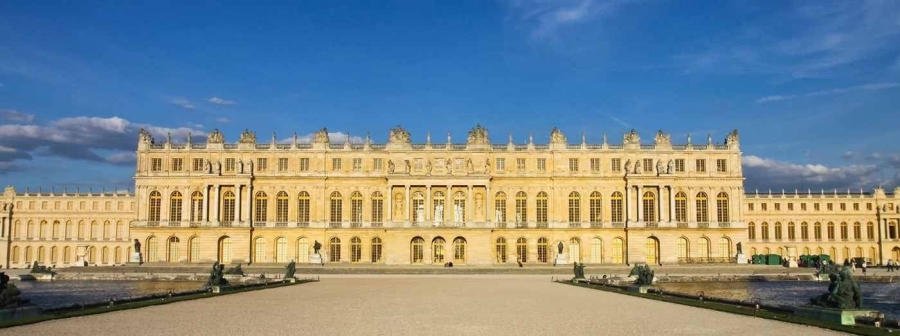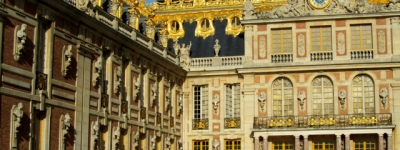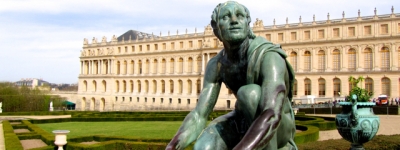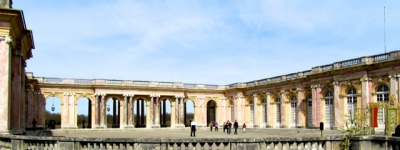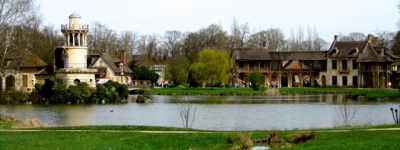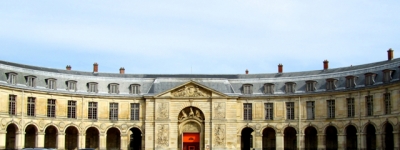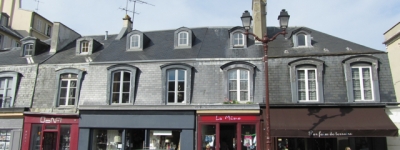World Heritage
The prestigious palace complex, including the Trianon palaces and the park of Versailles, is the result of a century and a half of work commissioned by the kings of France and entrusted to their greatest artists. The strongest impression was of course left by Louis XIV, who decided on the expansion of the small existing castle of brick and stone, built in 1624 by his father, Louis XIII. The first additions occurred after 1661 under the direction of Louis Le Vau, in a dominant Italian style. André Le Nôtre would design the gardens, which were soon to be famous throughout Europe.
Versailles was considerably enlarged and radically changed after 1678, by Jules Hardouin-Mansart, who was able to impose a sober, colossal (the Palace of Versailles was developed next to the gardens at a length of 670 meters), homogeneous and majestic architectural style, now inseparable from the memory of the Sun King. The famous Hall of Mirrors between the War and Peace Salons, is the masterpiece of the classicist and typically French design, known more recently as the Louis XIV style. The Orangerie and the Grand Trianon are also the work of Hardouin-Mansart, who was assisted by Robert de Cotte for the Royal Chapel. The creations of Versailles from the 18th century are among the most perfect and most famous achievements of the Louis XV and Louis XVI styles : the Petit Trianon by Jacques Ange Gabriel in 1751, the decoration of Louis XV’s apartments by Verbeckt and Rousseau, and Marie-Antoinette’s apartments and hamlet by Richard Mique.
The classified area, introduced in 1979, includes the palace, the Grand and Petit Trianons and the park.
Criteria for selection
Criterion (i) : The ensemble of the palace and park of Versailles is a unique artistic achievement in its scale, quality and originality.
Criterion (ii) : Versailles has had considerable influence in Europe from the late 17th and 18th centuries. Wren used Versailles as inspiration at Hampton Court, Schlüter in Berlin, in designing the façades of the Royal Palace. Small versions of Versailles popped up everywhere in Europe. The gardens of Le Nôtre, designed by the architect himself or by his imitators, are too numerous to count : from Windsor at Cassel, to Sweden, Denmark, Russia ...
Criterion (vi) : The Palace of Versailles was the most appropriate, best-suited environment for the life of the court of France for a century and a half. It was during this time that Louis XIV perfected his code of courtly behavior – "etiquette". However, it was also where the people of Paris captured Louis XVI and Marie-Antoinette on October 6, 1789.
Source : UNESCO / ICOMOS
History
History of the Palace of Versailles
As a child, Louis XIII came to what are now the grounds of the palace with his father, Henry IV, to hunt in the forest. These fond memories prompted him to build a hunting lodge on the site in 1624. Through the acquisition of the manor of Versailles in 1631, he expanded his home during the following years. Louis XIII died in 1643.
From the 1660s onward, the young Louis XIV decided to settle there. To do this, he commissioned enormous works from his first architect, Louis Le Vau, which would last almost 40 years. The King did not want to demolish the structures built by his father, and from 1668 Le Vau built the so-called "envelope" of the oldest buildings located around the marble courtyard, in the heart of the palace. It includes the royal apartments and the reception rooms where the official life of royalty proceeded. The building was made in stone, its architecture inspired by an Italian style that was very fashionable and innovative at the time. Charles Le Brun undertook the interior decoration of the rooms. In addition to work on the expansion of the palace, the gardens were designed and assembled by André Le Nôtre. The wetlands were drained, the Grand Canal was created, and a huge network of water supply consisting of pipes and aqueducts was installed to irrigate the gardens and feed the hundreds of fountains.
From 1678 onward, a second round of works was initiated. The King decided to make Versailles the seat of his government. Jules Hardouin-Mansart became the First Architect of the King, and took over from Louis Le Vau. The north and south wings and the outbuildings were constructed in order to accommodate the entire royal family and court, nearly 4,000 people! The King, his court and the government finally moved to Versailles in 1682 from the castle of Saint-Germain-en-Laye, even before the end of the expansion work. It was a revolution in the lifestyle of the royal family and the court, accustomed to moving from castle to castle throughout the year.
After entrusting the realization of the Hall of Mirrors to Jules Hardouin-Mansart, Louis XIV had him finish the Royal Chapel, five years before his death. Apart from the decorations and interior furnishings, most of the palace and gardens that can be visited today are the work of the Sun King and his architects.
Louis XIV died in 1715, and the future Louis XV was no older than five years old.At that time, he left Versailles to return to Paris, yet returned to the palace seven years later to complete the work of his grandfather.Louis XV entrusted his new achievements and developments to Jacques Ange Gabriel.Under his direction, the scenery became more refined (including the Small Apartments, the Opera, the Hercules Salon).In the gardens, he constructed the Petit Trianon next to the Grand Trianon built by Louis XIV.
During the reign of Louis XVI, the kingdom's finances were in bad shape, and the King was content to simply maintain and renovate the palace. But Marie-Antoinette, his wife, made arrangements with architect Richard Mique to build an estate and a Norman hamlet where she could relax away from the pomp of the court.
The French Revolution broke out in 1789. The Palace of Versailles, as the emblem of absolute monarchy, could have been seriously affected during this period, and though some furniture was displaced and the gardens were left to overgrow, in the end the palace suffered little damage. Three years later, in 1792, at the fall of the monarchy, the palace was abandoned and was never again to be the primary residence of France’s rulers.
Napoleon I was particularly attracted by the Trianon palaces during his reign. He renovated and redecorated the interiors of the Grand Trianon, used as a spring home at the time, and left the Petit Trianon to be redesigned by his wife, the Empress Eugenie.
Louis XVIII brought some changes to the palace, but it was under the reign of Louis-Philippe, from 1830 onward, that the palace came back to life as a museum of the history of France, opened in 1837. Illustrating the history of France through 14 centuries (from the Middle Ages to the 19th century), the collections were constantly enriched, thanks particularly to the Revolutionary auctions of the time, which were rich with 18th-century furniture. Since the opening of the museum, the palace, park and gardens were gradually restored for visitors. As the symbol of royal absolutism and the embodiment of classical French art, today the palace welcomes four million visitors a year. The palace extends over 63,000 m2 and hosts 2,300 works of art, furniture, and artifacts.
The daily routine of the Sun King
The daily routine of Louis XIV was supposed to continue under the reigns of Louis XV and Louis XVI, but neither of them could bear this oppressive ceremonial. As often as possible, they took refuge in their private apartments or in the royal residences nearby. As the years passed, the Levées and Couchées were observed less and less frequently. And the courtiers complained that they never saw the King any more, much unlike during the time of Louis XIV.
The King's mornings
7:30-8 a.m. "Sire, it is time", the first Valet de Chambre awakens the King, and the First Levée begins. Doctors, familiars and a few favorites who enjoyed the privilege of the ceremony followed in succession into the bedchamber of the King who was washed, combed and shaved (every other day). The officers of the Chamber and the Wardrobe then entered for the Grande Levée during which the King was dressed and breakfasted on a bowl of broth. Only the most important personalities in the kingdom were admitted to observe this ritual. The number of attendants is estimated at around a hundred, all male.
10 a.m. : As they left the King's apartment, a procession formed in the Hall of Mirrors. Followed by his courtiers, the King crossed the whole breadth of the Grand Apartment. This was the moment when the crowd gathered along the passage of the royal cortège was at last able to catch a glimpse of the monarch. Some were even able to speak to him briefly or pass him a written request. The King sat in the tribune of the Royal Chapel to attend mass, for about thirty minutes.
11 a.m. : Back in his Apartment, the King held council in his cabinet. On Sundays and Wednesdays was the Council of State, Tuesdays and Saturdays were devoted to the Royal Council of Finances, and finally, on Mondays, Thursdays and Fridays there might be an extra Council of State to replace a Dispatch Council (domestic affairs) or a Religious Council (religious affairs). On these same days, the King might also decide to examine the progress of the building programs. Five or six ministers worked with the monarch who spoke little, listened much and then made his decision.
1 p.m. : In his bedchamber, the King dined alone, sitting at a table facing the windows. This meal was in principle a private one but Louis XIV used to receive all the men of the Court, in general those present at the Levée.
His afternoons
2 p.m. : The King gave his orders announcing his intentions for the afternoon in the morning. If he wished for a promenade, it was in the gardens, either on foot or in a carriage with the ladies. If he chose to hunt, the favorite sport of all the Bourbons, it took place in the grounds when the King preferred to shoot, or in the surrounding woodland when he rode to hounds.
6 p.m. : Often Louis XIV let his son preside over the indoor entertainments, like the evenings in the apartments. Meanwhile, he would sign the many letters prepared by his secretary and then go to the apartments of Madame de Maintenon where he would study an important dossier aided by one of his four secretaries of State.
The evenings
10 p.m. : The crowd squeezed into the antechamber of the King's apartments to attend the Grand Public Supper. The King would sit at the table, surrounded by members of the royal family. At the end of the meal, the monarch walked through his bedroom and into the salon to salute the ladies of the court. Then he withdrew to his cabinet to converse more freely with his family and a few close acquaintances.
11:30 p.m. : The Couchée, a public ceremonial where the King withdrew to his bedroom, was a shortened version of the Levée.
Source : Château de Versailles
Tourist Office
Versailles Tourist Office
2 bis Avenue de Paris
, 78000 Versailles
Website - tel : 01 39 24 88 88.
Open every day:
April through October: Tuesday to Sunday: 8:30 a.m. to 7 p.m. ;
Monday: 9:30 a.m. to 6 p.m. ;
November through March: Tuesday to Sunday: 8:30 a.m. to 5:30 p.m. ; Monday: 11 a.m. to 5 p.m.
Tourist Office Branch
1 Bis Rue du Jeu de Paume, 78000 Versailles
Website - Tel: 01 39 24 88 88.
Opening Time:
Tuesday to Sunday: 2 p.m. to 6 p.m.
Accommodation available for visitors with disabilities. The tourist office offers all the documentation to visit the palace and the town of Versailles.
Museums
Main museums of Versailles
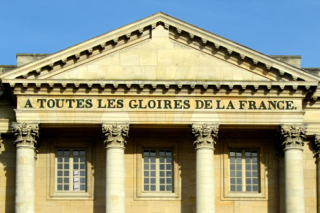
The musée de l'Histoire de France
Website
This history museum is dedicated to “all the glories of France."The 19th century was a particularly turbulent time for French politics. As a result, when Louis-Philippe came into power in 1830, he hoped not only to promote a message of reconciliation and national unity to help heal the divisions of French society, but also to establish his legitimacy as ruler. With this in mind, he created the Musée de l’Histoire de France (Museum of the History of France). After having been the residence of the kings of France, Versailles became a museum honoring its heroes.
The impressive collection spread among the many rooms offers visitors a chronological and thematic visit throughout the history of the country. Louis-Philippe brought together all of the paintings and sculptures relating to France’s national history that could be found in the collections of the Royal Museums and made many purchases. In total, the more than 6,000 paintings and 3,000 sculptures made this museum the richest collection on the history of France. After his death, the collections continued to grow through acquisitions, bequests and donations of furniture and objects. Today it is simply the biggest and richest museum of the history of France (spanning across 14 centuries).
Some rooms in the museum, such as the Salle du Sacre (Sacre Room), the Salle de 1792 (1792 Room), the Galerie des Batailles (The Battles Gallery) and the Salle de 1830 (1830 Room) can be visited independently after the tour of the Grands Appartements. The other rooms are accessible during the guided visits.
The Gallery of Coaches
Grande écurie du Roi, Avenue Rockefeller, 78000 Versailles
Website - tel: 01 30 83 78 00
Free entrance.
Open daily except on Monday:
April through October: 12:30 p.m. yo 6:30 p.m.
November through March: 12:30 p.m. to 5:30 p.m.
Guided tour including the stables and the gallery of coaches available.
Booklet for children.
Located opposite the Palace, within the Grande Ecurie. The Gallery of Coaches hosts a collection of Ancien Régime and Empire carriages assembled by the king Louis-Philippe.You can admire gala berlins ordered for the marriage of Napoleon the 1st, Louis XVIII's funeral coach, the one from Charles X's coronation, Marie-Antoinette's kids carriages…
The Musée Lambinet (1751) – outside the perimeter of the classified site
54 Boulevard de la Reine, 78000 Versailles
Website - tel: 01 30 97 28 75.
Full price / reduced price: €5 / €3.50. Free for those under 18 years old, and free general admission the last Sunday of the month.
Open daily except on Friday: 2 p.m. to 6 p.m.
The Musée Lambinet (Museum of the City of Versailles) resides in a beautiful 18th-century mansion. Its collections are divided into three themes:
Ground floor : a selection of paintings and sculptures from the 16th to the 19th century.
1st floor : a reconstructed 18th-century apartment offers a glimpse into the lives of aristocrats at the time
2nd floor : a collection detailing the history of the city of since its inception, including its role during the Revolution
Events
Main events of the year at the Palace of Versailles
Château de Versailles Spectacles
Grille du Dragon - Pavillon des Roulettes
Website - tél : 01 30 83 78 89
.
Discover the outdoor light and water shows Grandes Eaux Musicales (Musical Fountains Show) and Les Grandes Eaux Nocturnes (The Night Fountains Show) as well as the concerts organized year-round at symbolic sites around the palace : the Hall of Mirrors, the Royal Opera, the Royal Chapel ...
Les Grandes Eaux Musicales (April to October)
Full price/ reduced price: €9.50/ €8. Free for children under 6 years old
From April through October: Saturday and Sunday. In June: Tuesday, Saturday and Sunday.
(The Musical Fountains Show) A magical, musical stroll through the illuminated gardens.
Les Jardins Musicaux (April to October)
Full price/ reduced price: €8.50/ €7.50. Free for children under 6 years old
From April to October, on Tuesday and Friday. In June, on Friday only.
(The Musical Gardens) A musical journey in the heart of the gardens and orchards.
Les Grandes Eaux Nocturnes (End of June to September)
Full price / reduced price: €26 / 6 to 18 years old: €22. Free for children under 6 years old
From mid-June to mid-September, on Saturdays: 8:30 p.m. to 11:05 p.m.
(The Fountains Night Show) A nighttime walk in the gardens featuring an exceptional scenery, water works, fireworks ...
La Sérénade Royale de la Galerie des Glaces (June to September)
Full price/ reduced price: €24/ €21. Free for children under 6 years old.
From mid-June to mid-September, on Saturdays between 6:30 p.m. to 8 p.m.
(The Royal Serenade in the Hall of Mirror) Just before the Grandes Eaux Nocturnes, dancers and musicians invite visitors to participate in a French ball.
July 14th Fireworks, to celebrate the national holiday.
Attention visitors: this event is held on the evening of July 13th at 11 p.m. !
Transport
Getting to Versailles
By car from Paris
From the Porte d'Auteuil via highway A13, exit Versailles Centre
Distance from other classified sites
Paris - Banks of the Seine: 20 km (12.5 mi), time : 40 minutes
Chartres Cathedral: 75 km (46.5 mi), time: 1 hour, 5 minutes
Fontainebleau: 72 km (44.5 mi), time : 55 minutes
By train from Paris
Transilien
Website - tel : 36 58.
Departures from Paris, Gare Montparnasse: Line N, arrival at Gare de Versailles Chantiers (time: 30 minutes) ; a 10-minute walk to and from the palace.
Departures from Paris, gare Saint Lazare: Line L, arrival at Gare de Versailles Rive Droite (time: 30 minutes) ; a 15-minute walk to and from the palace.
From downtown Paris, via RER line C: arrival at Gare de Versailles Rive Gauche ; a 5 to 7-minute walk to and from the palace.
By bus
City buses from Paris
RATP bus, line 171 from Metro station Pont de Sevres (15th district). Time : 35 minutes
Charter bus
Phebus
Gare des Chantiers, Place Raymond Poincaré, 78000 Versailles
Website - tel : 01 39 20 16 20.
Getting around the grounds
Parking
4 parking lots around the castle (fees applicable): Place d'Armes, Bailly Avenue and close to the Grand and Petit Trianons.
Access to the Trianon palaces and Marie-Antoinette’s Estate by car
The Trianon palaces and Marie-Antoinette's Estate can be accessed either by passing through the palace gates via the Grille d’Honneur or directly via the Grille de la Reine or the Grille Saint Antoine (Fee).
On foot
The distances between attractions can be quite long on foot. Allow half an hour to get from castle to the Trianon palaces.
By shuttle train
A shuttle train, departing from the Terrasse Nord (North Terrace), takes visitors to Marie-Antoinette’s Estate to the Grand Trianon to the Grand Canal. Full price / reduced price, round-trip : €8 / €6.10. Free for children under 12 years old.
Other means of transport
Rental boats available for rides on the Grand Canal (€17/hour). Bicycle rental (€8.50/hour, at the entrance of the park, next to the Grand Canal). Also available : Segway (€35/hour), carriage rides or pony rides for children.
Sleeping / Eating
Hôtel around the Palace of Versailles
Trianon Palace *****
1 Boulevard de la Reine, 78000 Versailles
Website - Tel: 01 30 84 50 00.
Room from €329.
Restaurants around the Palace of Versailles
Picnicking is allowed in the park but not in the gardens.
Angelina tea room
Closed to Petit Trianon and another one on the 1st floor of the Palace.
Website - Tel: 01 39 20 08 32.
Well placed for taking a break near the Petit Trianon. On-site restaurant and tea room.
La Petite Venise
Website - tel : 01 39 53 25 69
"Lunch formule": €31.50.
At the start of the Grand Canal, near the restaurant La Flotille. Italian restaurant, tearoom, terrace.
La Flottille - traditional cuisine along the Grand Canal
Website - tel : 01 39 51 41 58.
Main course around €15.
Brasserie de la Girandole - on-site or take-away food
Tel: 01 39 07 01 87.
Located in the heart of the gardens, in the bosquet de la Girandole. Open from April to October.
Gordon Ramsey - gourmet cuisine
1 Boulevard de la Reine, 78000 Versailles
Website - Tel: 01 30 84 50 18.
"Menu" from €148.
Only open for dinner.
Downtown
The selection of restaurants proposed below consists of restaurants that offer a good price/quality value. “Formule” corresponds to a lunch special with a starter and a main course, or a main course and a dessert. The “menus” usually consist of a starter, a main course and a dessert, for lunch or dinner.
L'Angélique - gourmet cuisine
27 Avenue de Saint Cloud, 78000 Versailles
Website - tel : 01 30 84 98 85.
"Lunch formule" €35. "Menu" from €51.
La Table du 11 - traditional cuisine revisited
8 Rue de la Chancellerie, 78000 Versailles
Website - tel: 09 83 34 76 00.
"Lunch menu" €45. "Dinner menu" from €80.
Other restaurants, bars and snacks are located around the lovely Market square.

